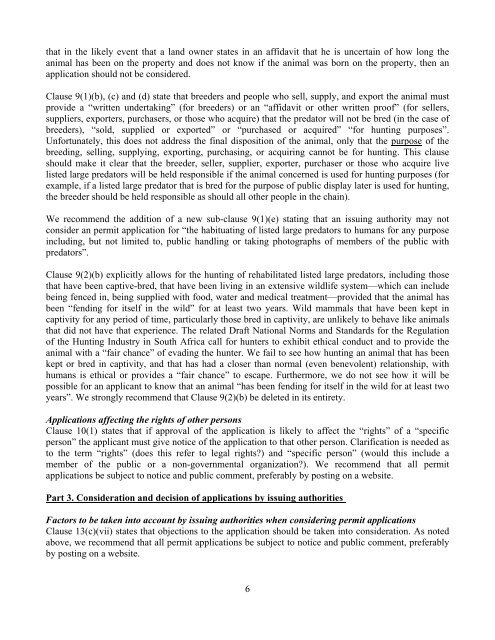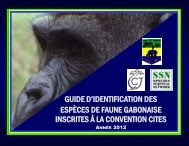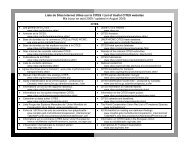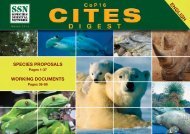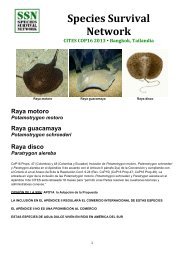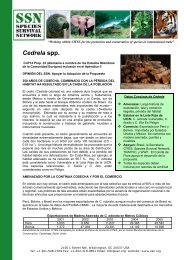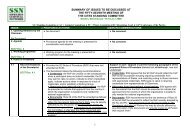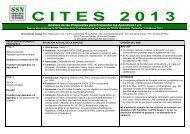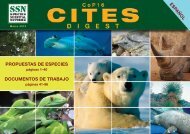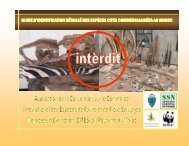SSN's Comments on South Africa's Regulations on Threatened and ...
SSN's Comments on South Africa's Regulations on Threatened and ...
SSN's Comments on South Africa's Regulations on Threatened and ...
You also want an ePaper? Increase the reach of your titles
YUMPU automatically turns print PDFs into web optimized ePapers that Google loves.
that in the likely event that a l<strong>and</strong> owner states in an affidavit that he is uncertain of how l<strong>on</strong>g the<br />
animal has been <strong>on</strong> the property <strong>and</strong> does not know if the animal was born <strong>on</strong> the property, then an<br />
applicati<strong>on</strong> should not be c<strong>on</strong>sidered.<br />
Clause 9(1)(b), (c) <strong>and</strong> (d) state that breeders <strong>and</strong> people who sell, supply, <strong>and</strong> export the animal must<br />
provide a “written undertaking” (for breeders) or an “affidavit or other written proof” (for sellers,<br />
suppliers, exporters, purchasers, or those who acquire) that the predator will not be bred (in the case of<br />
breeders), “sold, supplied or exported” or “purchased or acquired” “for hunting purposes”.<br />
Unfortunately, this does not address the final dispositi<strong>on</strong> of the animal, <strong>on</strong>ly that the purpose of the<br />
breeding, selling, supplying, exporting, purchasing, or acquiring cannot be for hunting. This clause<br />
should make it clear that the breeder, seller, supplier, exporter, purchaser or those who acquire live<br />
listed large predators will be held resp<strong>on</strong>sible if the animal c<strong>on</strong>cerned is used for hunting purposes (for<br />
example, if a listed large predator that is bred for the purpose of public display later is used for hunting,<br />
the breeder should be held resp<strong>on</strong>sible as should all other people in the chain).<br />
We recommend the additi<strong>on</strong> of a new sub-clause 9(1)(e) stating that an issuing authority may not<br />
c<strong>on</strong>sider an permit applicati<strong>on</strong> for “the habituating of listed large predators to humans for any purpose<br />
including, but not limited to, public h<strong>and</strong>ling or taking photographs of members of the public with<br />
predators”.<br />
Clause 9(2)(b) explicitly allows for the hunting of rehabilitated listed large predators, including those<br />
that have been captive-bred, that have been living in an extensive wildlife system—which can include<br />
being fenced in, being supplied with food, water <strong>and</strong> medical treatment—provided that the animal has<br />
been “fending for itself in the wild” for at least two years. Wild mammals that have been kept in<br />
captivity for any period of time, particularly those bred in captivity, are unlikely to behave like animals<br />
that did not have that experience. The related Draft Nati<strong>on</strong>al Norms <strong>and</strong> St<strong>and</strong>ards for the Regulati<strong>on</strong><br />
of the Hunting Industry in <strong>South</strong> Africa call for hunters to exhibit ethical c<strong>on</strong>duct <strong>and</strong> to provide the<br />
animal with a “fair chance” of evading the hunter. We fail to see how hunting an animal that has been<br />
kept or bred in captivity, <strong>and</strong> that has had a closer than normal (even benevolent) relati<strong>on</strong>ship, with<br />
humans is ethical or provides a “fair chance” to escape. Furthermore, we do not see how it will be<br />
possible for an applicant to know that an animal “has been fending for itself in the wild for at least two<br />
years”. We str<strong>on</strong>gly recommend that Clause 9(2)(b) be deleted in its entirety.<br />
Applicati<strong>on</strong>s affecting the rights of other pers<strong>on</strong>s<br />
Clause 10(1) states that if approval of the applicati<strong>on</strong> is likely to affect the “rights” of a “specific<br />
pers<strong>on</strong>” the applicant must give notice of the applicati<strong>on</strong> to that other pers<strong>on</strong>. Clarificati<strong>on</strong> is needed as<br />
to the term “rights” (does this refer to legal rights?) <strong>and</strong> “specific pers<strong>on</strong>” (would this include a<br />
member of the public or a n<strong>on</strong>-governmental organizati<strong>on</strong>?). We recommend that all permit<br />
applicati<strong>on</strong>s be subject to notice <strong>and</strong> public comment, preferably by posting <strong>on</strong> a website.<br />
Part 3. C<strong>on</strong>siderati<strong>on</strong> <strong>and</strong> decisi<strong>on</strong> of applicati<strong>on</strong>s by issuing authorities<br />
Factors to be taken into account by issuing authorities when c<strong>on</strong>sidering permit applicati<strong>on</strong>s<br />
Clause 13(c)(vii) states that objecti<strong>on</strong>s to the applicati<strong>on</strong> should be taken into c<strong>on</strong>siderati<strong>on</strong>. As noted<br />
above, we recommend that all permit applicati<strong>on</strong>s be subject to notice <strong>and</strong> public comment, preferably<br />
by posting <strong>on</strong> a website.<br />
6


